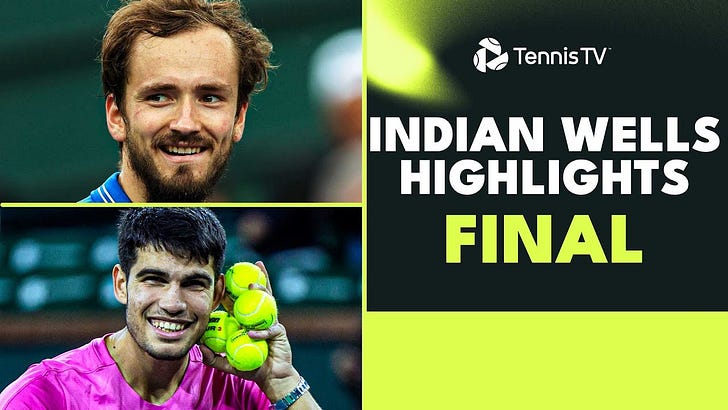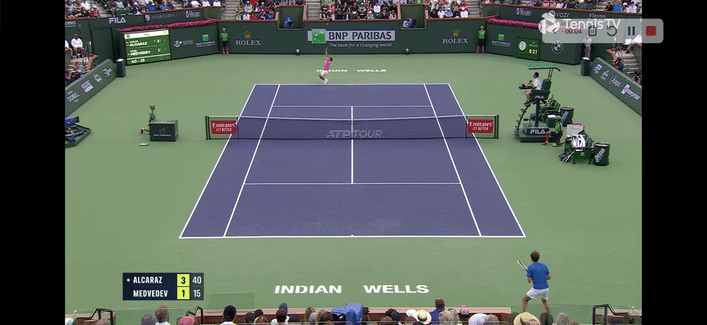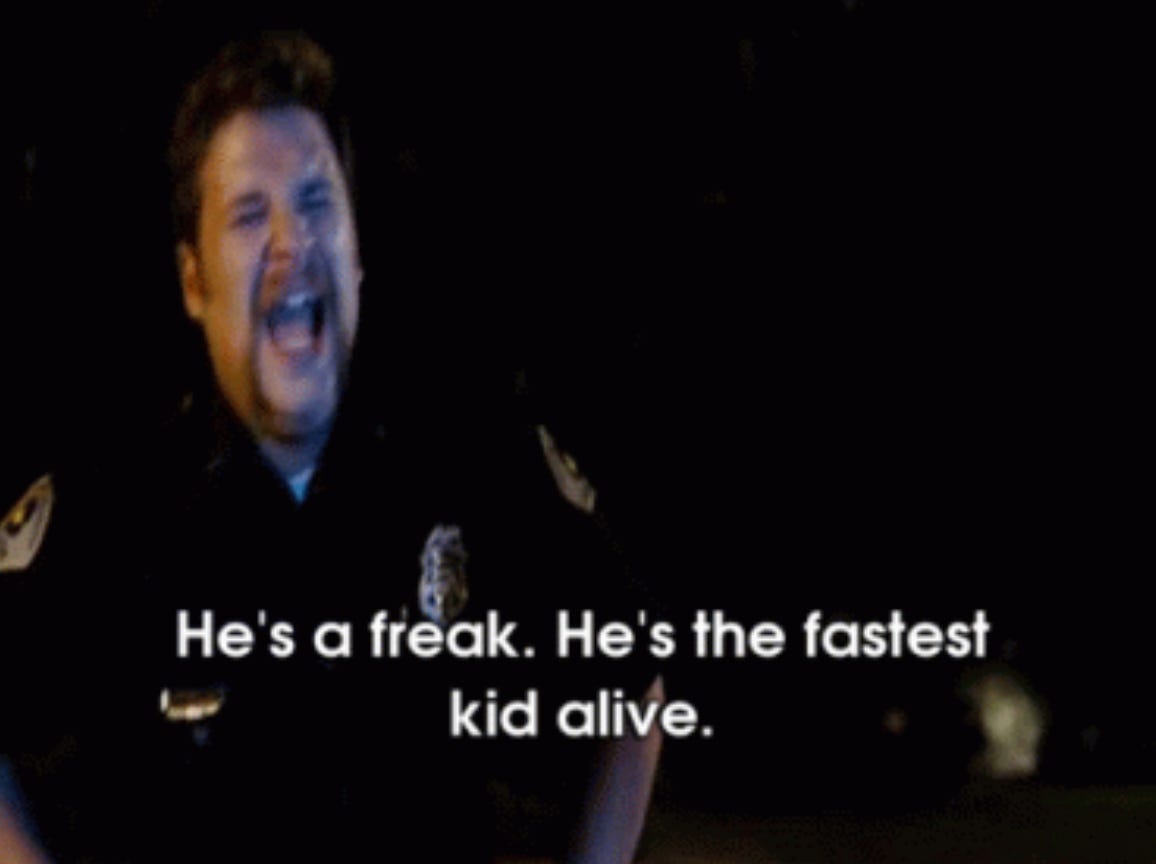Carlos Alcaraz defeated Daniil Medvedev 6/3 6/2 to claim his third Masters 1000 title and return to world number 1 in the ATP rankings. Alcaraz now owns 8 titles—the second most ever by a teenager (Nadal won 16 titles before turning 20).
Before the match I tweeted my usual thoughts on what I thought would be the keys for each player:

The first rally of the match featured many of the points I raised: Medvedev’s outrageously deep return position; the importance of the backhand crosscourt pattern for Medvedev; and the subsequent ability of Alcaraz to go backhand line so that he could find more forehand patterns.

Alcaraz’s Ad-court tactic of standing wide and using the kick serve meant he stretched the Russian into—quite frankly—ridiculous court positions that made winning return points very difficult. When you hit flat from this deep—as Medvedev does—it’s very hard to be effective on a slow hard court against a guy with so many tools on the belt.
To make matters worse, Alcaraz came out timing the ball beautifully from the start. He absolutely tagged his first return of the match and then skipped around an inside-out forehand for a 94mph winner.
Medvedev threw in a double fault and a tame backhand miss in the net in his opening service game. He was flat, and Alcaraz seized the break on his first opportunity. Again in this break point below, you can see the tactics of both play out: Medvedev is content to trade backhands, Alcaraz wants a forehand, so he takes the backhand up the line, but Medvedev doesn’t want to trade forehands, so he goes forehand line to Alcaraz’s backhand to establish that pattern again, but Carlos doesn’t hesitate, stepping in and punching a backhand winner cross court. It’s that instinctive aggression on big points that makes him so chaotic. On other days he misses that ball and it’s a smart play from Medvedev, but when he’s on you kind of have to go along with the show and just appreciate you’re watching someone special.
Part I

Part II

Before the match I also pointed out that the Alcaraz drop shot would have to be great off the return:

Unlike Sinner yesterday, who at times tried to take the return early and then have to move backward as he recovered to the middle, one advantage of the deep return position is that you have momentum carrying you forward when recovering. The Alcaraz drop shot had to be great to be effective, and most of the time he played it to perfection

And on serve-volley points Alcaraz had an acute sense of his opponent’s position, feathering this one short with a degree of control Rod Laver would be proud of (and who was attending the match).
The slow court coupled with Medvedev’s relatively benign rally ball meant the whole suite of Alcaraz tricks was on the menu. In previous rounds, Sinner and Auger-Aliassime had rushed him through sheer power. Those matches were more reactive; shots were fired wildly through the thin desert air in a bid to get on top of rallies. The patience Alcaraz displayed in this final hint to his acute sense of tennis IQ, and reminded everyone (or me, at least, after my semi-final analysis) that he isn’t just mindlessly slashing at balls like a butcher; the man is a surgeon. Speaking of players with surgical precision in attack, check out the similarity in forehand prep between a ~2006 Federer and Alcaraz. Scalpels slightly inverted, tip up, with the wrist extended to present the strings to the photo gallery courtside.1
And along with some of the best footwork and speed in the game, Alcaraz was peppering balls inside the forecourt right after the return. The below graphic was taken after the first set.
There was nothing Medvedev could do to either hurt Alcaraz on offense or present a defensive problem for him. As a result, the Russian was limited to 5 winners for the match:
I could add a handful of other forehands/backhands/volleys to this review, but I think you get the point. At his best, Alcaraz is already one of the most complete players the game has ever seen. His serve is touching the high 130s, his forehand is one of the best in the game, his backhand is a reliable shield that he can also attack with, and his intangibles—the drop shot, slice, volleys, and court awareness—are the best in the game as a package. Oh and he’s quick as shit. With a great attitude.
As Federer always said, there will be new stars to carry the torch in the post-Big-3 era, and Alcaraz has arrived right on cue in the last 18 months.
The tour lands in Miami this week for the second leg of the Sunshine Double. Alcaraz is the defending champion, and unfortunately for tennis, Djokovic is still absent due to vaccine requirements. It means a match between the two best players in the world will have to wait until the clay season.
I’ll be back after Miami with some match analyses and thoughts. Always happy to answer questions in the comments, and as always, please share this article or newsletter more broadly if you think someone else might like it.
From here Alcaraz usually lifts his elbow higher to further invert the racquet tip to generate more speed, but when he’s a little rushed it’s remarkably similar to Rog. The slight difference in racquet angle—where Alcaraz’s strings a pointing a little higher—are due to an eastern (Federer) v semi-western (Alcaraz) forehand grip.












Another terrific write-up, Hugh!
This might be a bit of recency bias, but I don't see how Djokovic could have come out with a different result vs the form that Alcaraz showed yesterday (though the scoreline liekly would have been closer). The kid has speed, touch and power that I think would have also outmaneuvered the likes of current Djokovic. What do you think?
Looks like Alcaraz made the change to shorten his forehand when rushed, a flaw on running and rushed forehands you've previously described. I've noticed he put extra effort into all running forehands this tournament, as if to showcase his training in improving that (former) weakness.
Have you noticed improvement in his backhand technique in regards to the outside vs inside takeback issue you've discussed in the past? It would mainly be an issue on lower balls, but he gets very low by bending his knees and he's also not that tall, so maybe the outside prep isn't going to be a big issue for him?